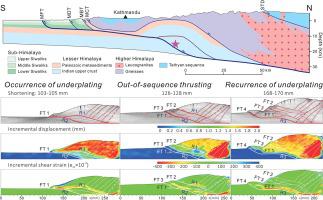当前位置:
X-MOL 学术
›
J. Asian Earth Sci.
›
论文详情
Our official English website, www.x-mol.net, welcomes your
feedback! (Note: you will need to create a separate account there.)
Tectonic underplating versus out-of-sequence thrusting beneath the Lesser Himalaya: Insights from the analogue modeling of the Nepal Himalaya fold-and-thrust belt
Journal of Asian Earth Sciences ( IF 2.7 ) Pub Date : 2020-08-01 , DOI: 10.1016/j.jseaes.2019.104167 Li Shen , Dong Jia , Zhen Zhang , Zhuxin Chen , Hongwei Yin , Xiaojun Wu , Yanjun Wang , Chuang Sun , Jian Cui , Xiaogen Fan
Journal of Asian Earth Sciences ( IF 2.7 ) Pub Date : 2020-08-01 , DOI: 10.1016/j.jseaes.2019.104167 Li Shen , Dong Jia , Zhen Zhang , Zhuxin Chen , Hongwei Yin , Xiaojun Wu , Yanjun Wang , Chuang Sun , Jian Cui , Xiaogen Fan

|
Abstract The Nepal Himalaya fold-and-thrust belt is a classical two-decollement thrust–fold system. The belt has been extensively studied by analogue and numerical modeling, but the formation mechanism of the mid-crustal duplex structure beneath the northern part of the Lesser Himalaya remains debated. The formation of this thrust duplex has been attributed either to tectonic underplating along new ramps in response to the subducting Indian Plate, or to out-of-sequence thrusting along preexisting ramps. We conducted a series of experiments using analogue models, employing a model setup that was faithful to the geological setting of the Nepal Himalaya. We used industrial computed tomography (CT) and particle image velocimetry (PIV) to generate detailed deformation maps. The analogue models successfully reproduce the main structure of the Nepal Himalaya fold-and-thrust belt, showing that the two competing processes (i.e., underplating along new ramps and out-of-sequence thrusting along preexisting ramps) operate alternately to form the duplex structure. The models also show that underplating is associated with extensive foreland sedimentation, analogous to the foreland molassic sedimentation in the Sub-Himalaya, which leads to a systematic recession of the deformation front and a smaller horse. Finally, the recognition that out-of-sequence thrusting occurs in the interval between major underplating events provides important insights into the origin of the 2015 M W 7.8 Gorkha earthquake.
中文翻译:

小喜马拉雅山下的构造底板与无序逆冲:来自尼泊尔喜马拉雅褶皱冲断带模拟模型的见解
摘要 尼泊尔喜马拉雅褶皱冲断带是一个经典的二解冲冲褶皱系统。该带已通过模拟和数值模拟进行了广泛的研究,但小喜马拉雅北部下方中地壳双相结构的形成机制仍有争议。这种逆冲双相体的形成要么归因于响应印度板块俯冲的新斜坡上的构造底床,要么归因于沿先前存在的斜坡的无序逆冲。我们使用模拟模型进行了一系列实验,采用了忠实于尼泊尔喜马拉雅山地质环境的模型设置。我们使用工业计算机断层扫描 (CT) 和粒子图像测速 (PIV) 来生成详细的变形图。模拟模型成功地再现了尼泊尔喜马拉雅褶皱冲断带的主体结构,表明两个相互竞争的过程(即沿新斜坡的底侵和沿原有斜坡的无序逆冲)交替运行以形成复式结构. 模型还表明,底板与广泛的前陆沉积有关,类似于亚喜马拉雅的前陆糖质沉积,导致变形前缘的系统性衰退和较小的马。最后,对发生在主要底板事件之间的无序逆冲的认识为了解 2015 年 7.8 兆瓦廓尔喀地震的起源提供了重要见解。沿着新坡道的底板和沿着预先存在的坡道无序推进)交替运行以形成双工结构。模型还表明,底板与广泛的前陆沉积有关,类似于亚喜马拉雅的前陆糖质沉积,导致变形前缘的系统性衰退和较小的马。最后,对发生在主要底板事件之间的无序逆冲的认识为了解 2015 年 7.8 兆瓦廓尔喀地震的起源提供了重要见解。沿着新坡道的底板和沿着预先存在的坡道无序推进)交替运行以形成双工结构。模型还表明,底板与广泛的前陆沉积有关,类似于亚喜马拉雅的前陆糖质沉积,导致变形前缘的系统性衰退和较小的马。最后,对发生在主要底板事件之间的无序逆冲的认识为了解 2015 年 7.8 兆瓦廓尔喀地震的起源提供了重要见解。这导致变形前缘的系统性衰退和较小的马匹。最后,对发生在主要底板事件之间的无序逆冲的认识为了解 2015 年 7.8 兆瓦廓尔喀地震的起源提供了重要见解。这导致变形前缘的系统性衰退和较小的马匹。最后,对发生在主要底板事件之间的无序逆冲的认识为了解 2015 年 7.8 兆瓦廓尔喀地震的起源提供了重要见解。
更新日期:2020-08-01
中文翻译:

小喜马拉雅山下的构造底板与无序逆冲:来自尼泊尔喜马拉雅褶皱冲断带模拟模型的见解
摘要 尼泊尔喜马拉雅褶皱冲断带是一个经典的二解冲冲褶皱系统。该带已通过模拟和数值模拟进行了广泛的研究,但小喜马拉雅北部下方中地壳双相结构的形成机制仍有争议。这种逆冲双相体的形成要么归因于响应印度板块俯冲的新斜坡上的构造底床,要么归因于沿先前存在的斜坡的无序逆冲。我们使用模拟模型进行了一系列实验,采用了忠实于尼泊尔喜马拉雅山地质环境的模型设置。我们使用工业计算机断层扫描 (CT) 和粒子图像测速 (PIV) 来生成详细的变形图。模拟模型成功地再现了尼泊尔喜马拉雅褶皱冲断带的主体结构,表明两个相互竞争的过程(即沿新斜坡的底侵和沿原有斜坡的无序逆冲)交替运行以形成复式结构. 模型还表明,底板与广泛的前陆沉积有关,类似于亚喜马拉雅的前陆糖质沉积,导致变形前缘的系统性衰退和较小的马。最后,对发生在主要底板事件之间的无序逆冲的认识为了解 2015 年 7.8 兆瓦廓尔喀地震的起源提供了重要见解。沿着新坡道的底板和沿着预先存在的坡道无序推进)交替运行以形成双工结构。模型还表明,底板与广泛的前陆沉积有关,类似于亚喜马拉雅的前陆糖质沉积,导致变形前缘的系统性衰退和较小的马。最后,对发生在主要底板事件之间的无序逆冲的认识为了解 2015 年 7.8 兆瓦廓尔喀地震的起源提供了重要见解。沿着新坡道的底板和沿着预先存在的坡道无序推进)交替运行以形成双工结构。模型还表明,底板与广泛的前陆沉积有关,类似于亚喜马拉雅的前陆糖质沉积,导致变形前缘的系统性衰退和较小的马。最后,对发生在主要底板事件之间的无序逆冲的认识为了解 2015 年 7.8 兆瓦廓尔喀地震的起源提供了重要见解。这导致变形前缘的系统性衰退和较小的马匹。最后,对发生在主要底板事件之间的无序逆冲的认识为了解 2015 年 7.8 兆瓦廓尔喀地震的起源提供了重要见解。这导致变形前缘的系统性衰退和较小的马匹。最后,对发生在主要底板事件之间的无序逆冲的认识为了解 2015 年 7.8 兆瓦廓尔喀地震的起源提供了重要见解。











































 京公网安备 11010802027423号
京公网安备 11010802027423号